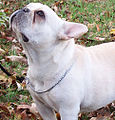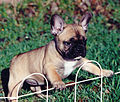Want to start a fight on a French Bulldog discussion list? Bring up the topic of French Bulldog coat colors. There are few other topics more guaranteed to get threads going of 75 or more responses, or more promising of exchanges like ‘oh yeah? Sez you’ and ‘You wouldn’t know medelian genetics if it jumped up and bit you in the face’.
There’s a fairly simple reason for this, actually – complexity. Few if any breeds come in the staggering array of allowable colors and patterns seen in French Bulldogs. Our standard in North America pretty much states ‘except for these few disallowed colors, have at it, dog breeders!’. To be more precise, the American Kennel Club standard for the French Bulldog says –
Acceptable colors – All brindle, fawn, white, brindle and white, and any color except those which constitute disqualification. All colors are acceptable with the exception of solid black, mouse, liver, black and tan, black and white, and white with black, which are disqualifications. Black means black without a trace of brindle.
Read that again, carefully –
any color except those which constitute disqualification
That means that if I can genetically engineer myself a glow in the dark pink Frenchie, I could register and show it.
Night shows would be particularly interesting to show one at, don’t you think?
The European standards are a bit tougher on colors, with the FCI standard stating –
– Uniformly fawn, brindled or not , or with limited patching (pied).
– Brindled fawn or not, with medium or large patching.
All the fawn shades are admitted, from the red to light brown (café au lait) colour. The entirely white dogs are classified in “brindled fawn with large white patching”. When a dog has a very dark nose, dark eyes with dark eyelids, certain depigmentations of the face may exceptionally be tolerated in very beautiful subjects.
The FCI standard doesn’t need to list specific DQs (or disqualifications), as their standard has a short, concise list of allowable colors, instead. So, rather than the American standard, which tells us ‘anything other than these few colors is allowed’, the FCI standard says ‘nothing other than these few colors is allowed’.
Over in the UK, the standard says –
Brindle, pied or fawn. Tan, mouse and grey/blue highly undesirable.
Brindle: a mixture of black and coloured hairs. May contain white provided brindle predominates.
Pied: white predominates over brindle. Whites are classified with pieds for show purposes; but their eyelashes and eye rims should be black. In pieds the white should be clear with definite brindle patches and no ticking or black spots.
Fawn: may contain brindle hairs but must have black eye lashes and eye rims.
Reading this, one would assume that ‘cream’, as an ee expression of fawn, would be allowed. One would, however, be wrong. The British French Bulldog breeders are almost completely uniform in their rejection of anything other than what we refer to as ‘Black Masked Fawn’ – those smutty, tan colored dogs, with the clear black masks. Even the masked red fawns and red fawn pieds are still rejected. In fact, the predominance of the red fawn pied dogs we see in North America can be traced to a handful of UK dogs exported to the US, dogs which were sold mainly because their color was not showable in the UK.
These ‘DQs’ might not be specified in the standard, but they are still accepted as the norm – and if I’m wrong about this, and attitudes are changing, I’d love to hear about it.
The issue of cream versus fawn versus black masked fawn is of particular interest to most North American French Bulldog breeders, where the exact method of inheritance is still open to debate. I’ll discuss further on the vagaries of coat color genetics another time.
For now, I’ll leave you with the color example chart I created for Wikipedia, and which you can also find on French Bulldog Z. As I state repeatedly on both sites, these photos and their corresponding color descriptions are listed as examples only, and are open to debate. The only truism when it comes to French Bulldog coat colors is there are more descriptive color names than there are colors, and everyone has their own preference.
It should also be pointed out that some color terms are subjective, with each breeder having their own opinion as to what defines ‘fawn pied’, ‘honey pied’, etc. The examples listed below should be viewed objectively, and are open to debate. In other words, don’t bother sending me snippy letters if you disagree with my descriptions, as I already have a file of about 200 of those. Polite debate, however, is welcomed.
Click thumbnails to see full sized images.
|
|
|

|
Black brindle – also known as Seal brindle – so dark it may appear black, but closer inspection will reveal at least a few lighter colored hairs.
|
|
|
|

|
This color pattern is sometimes referred to as reverse brindle. It refers to the fact that fawn is more predominant than the black brindling. In the dog shown, there is also a black mask present.
|
|
|
|

|
Tiger brindle is a term reserved for dogs with a coat pattern comprising a fairly regular pattern of alternating fawn and black stripes, similar in appearance to the coat of a tiger.
|
|
|
|

|
Pale cream French Bulldog. Creams can range in hue from deep amber to rich butterscotch to palest gold. This color is generally considered to be a dilution of fawn, minus the masking gene.
|
|
|
|

|
This color and pattern are referred to as black masked RED fawn, due to the rich red hues of the fawn base coat. We have seen fawns in all shades, from brick red to honey to lemon yellow.
|
|
|
|

|
This color and pattern are referred to as black masked fawn. The base color of the coat can vary in shade from red to tan. The mask refers to the marking pattern on the face.
|
|
|
|

|
This pattern is referred to as brindle pied. Brindled areas – areas where fawn is overlaid with black striping – are interspersed with areas of white coat. Markings can be slight, or predominant.
|
|
|
|

|
Red fawn pied French Bulldogs. Paler versions are sometimes referred to as fawn pied, lemon pied or honey pied. As with all Frenchies, there may be a mask associated with this pattern.
|
|
|
|

|
Ticked Pied. Dog has obvious freckled markings among the white areas of the body. Only the KCofE standard specifies ‘ticking’ as a DQ, but this pattern still tends to be heavily penalized in show rings everywhere.
|
|
|
|

|
This is referred to as blue, or blue brindle. Brindle markings on this dog have a “grey” hue, and base coat color is a solid blue-grey. It has been debated whether or not this color is also what the standards refer to as ‘mouse‘.
|
|
|
|

|
A Blue Pied French Bulldog. “Blue” Frenchies are a result of the ‘d’ or dilute gene. In this form, the dilute factor has caused the black hairs to become blue. Pigment on nose and pads is also a greyish blue in color, and eyes are often blue or yellowish gold. Again, this color has also been referred to as mouse.
|
|
|
|

|
Blue-Fawn A variation of blue, with coloring being seen most clearly in the masking points on the face. Typically they have green/grey eyes. It is said that they are usually produced by a fawn or red fawn parent.
|
|
|
|

|
This color can be referred to as either liver or brown – each is a disqualification within the AKC or FCI breed standards. Dog has NO brindling, and is a uniform reddish – brown, with self pigmented lips, nose, pads,etc. Eyes have a yellowish hue.
|
|
|
|

|
Black and tan French Bulldog. Undoubtedly the rarest of the disqualified colors, this is still an extremely striking marking pattern. It has been theorized that black and tan was initially designated a dq because it is a dominant marking pattern in canines
|















